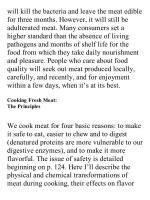On food and cooking the science and lore of the kitchen ( PDFDrive ) 29
Bạn đang xem bản rút gọn của tài liệu. Xem và tải ngay bản đầy đủ của tài liệu tại đây (165.81 KB, 2 trang )
FarmhousetoFactory
Preindustrial Europe In Europe, dairying
took hold on land that supported abundant
pasturagebutwaslesssuitedtothecultivation
of wheat and other grains: wet Dutch
lowlands, the heavy soils of western France
and its high, rocky central massif, the cool,
moist British Isles and Scandinavia, alpine
valleysinSwitzerlandandAustria.Withtime,
livestock were selected for the climate and
needsofdifferentregions,anddiversifiedinto
hundreds of distinctive local breeds (the
ruggedBrownSwisscowforcheesemakingin
the mountains, the diminutive Jersey and
Guernsey for making butter in the Channel
Islands). Summer milk was preserved in
equallydistinctivelocalcheeses.Bymedieval
times, fame had come to French Roquefort
and Brie, Swiss Appenzeller, and Italian
Parmesan. In the Renaissance, the Low
Countries were renowned for their butter and
exported their productive Friesian cattle
throughoutEurope.
Untilindustrialtimes,dairyingwasdone
onthefarm,andinmanycountriesmainlyby
women,whomilkedtheanimalsinearly
morningandafternoonandthenworkedfor
hourstochurnbutterormakecheese.Country
peoplecouldenjoygoodfreshmilk,butinthe
cities,withconfinedcattlefedinadequately
onspentbrewers’grain,mostpeoplesawonly
watered-down,adulterated,contaminatedmilk
hauledinopencontainersthroughthestreets.
Taintedmilkwasamajorcauseofchild
mortalityinearlyVictoriantimes.
Industrial and Scientific Innovations
Beginning around 1830, industrialization
transformedEuropeanandAmericandairying.
The railroads made it possible to get fresh
countrymilktothecities,whererisingurban
populations and incomes fueled demand, and
new laws regulated milk quality. Steam-









